
Salvia leucophylla, the San Luis purple sage or gray sage, is an aromatic sage native to the southern coastal mountain ranges of the Californias.

Salvia pratensis, the meadow clary or meadow sage, is a species of flowering plant in the family Lamiaceae, native to Europe, western Asia and northern Africa. The Latin specific epithet pratensis means "of meadows", referring to its preferred habitat. It also grows in scrub edges and woodland borders.
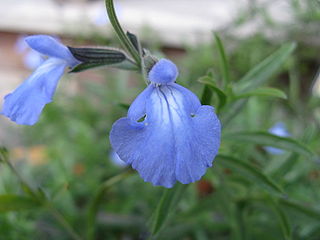
Salvia azurea, the azure blue sage, azure sage, blue sage or prairie sage, is a herbaceous perennial in the genus Salvia that is native to Central and Eastern North America.

Salvia brandegeei is a perennial evergreen shrub in the mint family known by the common names Santa Rosa Island sage or Brandegee's sage. It is a fragrant plant characterized by lavender flowers and dark green leaves. For many years, it was thought to be native only to Santa Rosa Island, one of the Channel Islands of California, until it was discovered along the coast of Baja California. It is threatened by development and mining along the mainland portions of its range, but otherwise has a stable population on Santa Rosa Island.

Salvia buchananii, or Buchanan's sage, is a species of flowering plant in the mint family Lamiaceae. It is a herbaceous perennial or subshrub that was only found in the wild in the northeastern extreme of the state of Querétaro, Mexico, after fifty years of cultivation as a garden plant.
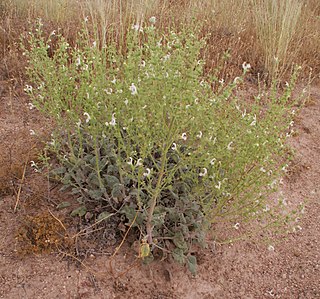
Salvia candidissima, the blazing white sage, is a herbaceous perennial native throughout western Greece, and parts of Turkey, Iraq, and Iran, generally between 2000 and 6500 feet elevation.

Salvia desoleana is a herbaceous perennial shrub native to the island of Sardinia in the Mediterranean. It is endemic to four or five specific locations on the island in sunny locations on limestone, granitic, and igneous rock. Salvia desoleana was named for the botanist Luigi Desole, and was first described in 1982.
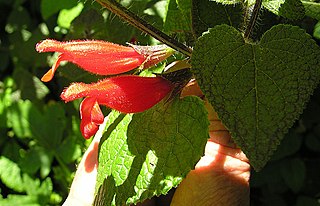
Salvia disjuncta, the southern Mexican sage, is a herbaceous perennial shrub native to the Mexican states of Oaxaca and Chiapas, with its range extending into Guatemala. It is found between 7,500 and 11,000 ft elevation in warm moist mountain habitat. It was collected by botanists from Strybing Arboretum in the 1980s and became available to nurseries in the 1990s.

Salvia holwayi is a herbaceous perennial native to Guatemala at elevations of 3,000–9,000 feet and at similar elevations in the Mexican state of Chiapas, where it frequently makes an understory in mixed pine and oak forests and thickets. It was named after 19th century plant and fungi collector Edward Willet Dorland Holway.
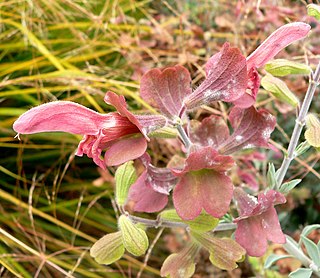
Salvia lanceolata is a perennial shrub native to a small area of coast on the Cape of Good Hope in South Africa. It is typically found growing in sandy ground at sea level, and on dry hills and flat ground up to 1000 feet elevation. Jean-Baptiste Lamarck, a pioneer in evolutionary theory, first described and named the plant "lanceolata" in 1791. Swedish botanist Carl Peter Thunberg, who was delayed in South Africa on the way to Japan, first collected it nearly twenty years earlier, along with approximately 3,000 plants that he later described. It wasn't until 1800 that Thunberg gave the plant the specific epithet "nivea", meaning 'snowy' in Latin, referring to the color of the foliage. Because of the rules of nomenclature, Lamarck's name had precedence because he was the first to name it.

Salvia lavandulifolia is a small woody herbaceous perennial native to Spain and southern France, growing in rocky soil in Maquis shrubland, often found growing with rosemary, Lavandula lanata, and Genista cinerea.

Salvia namaensis is an evergreen perennial shrub native to a limited area in Namibia and a wide area of South Africa. It is typically found growing on rocky slopes, shales, limestone hills, and sandy soils at 1,000 to 5,000 feet elevation. The specific epithet namaensis probably refers to the Nama tribe which is indigenous to Namaqualand, the region in Namibia where the plant grows.
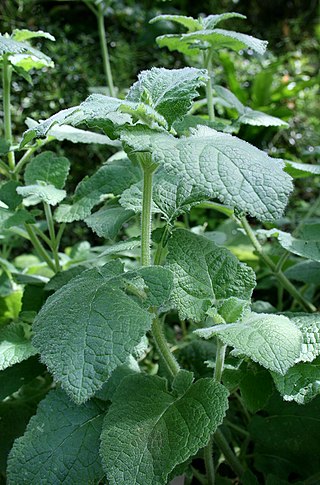
Salvia przewalskii is a herbaceous perennial plant native to the Chinese provinces of Gansu, Hubei, Sichuan, Xizang, and Yunnan, typically growing along stream banks, forest edges, among shrubs, and on granitic hillsides. It was described and named in 1881 by the Russian botanist Carl Maximowicz after the Russian explorer and botanist Nikolai Przhevalsky, who made several collecting trips to China in the 19th century. The plant is widely known throughout its native habitat for its medicinal properties.

Salvia recurva is a woody-based perennial native to the cloud forests of Central America, limited to the northern slopes of Oaxaca, Chiapas, and Guatemala at elevations around 10,000 feet (3,000 m). It grows where there is year-round warmth and abundant moisture in the air and on the forest floor. Salvia recurva was described by George Bentham in 1848, with the specific epithet referring to the distinct curve in the inflorescence when it first appears.

Salvia regla is a deciduous perennial that is native to a small area of the Chisos Mountains in west Texas and a large area of Mexico, in the states of Coahuila, Durango, and Oaxaca. The specific epithet is probably from the town of Regla in the state of Hidalgo. It is also referred to as the "queen of the Chisos Mountains". It has been widely planted along the Texas flyway for migrating birds, and is an important food source for hummingbirds returning to the tropics in September and October.

Salvia ringens is a hardy herbaceous perennial native to the southern and eastern parts of the Balkan Peninsula. With many colonies growing on Mount Olympus, the traditional "home of the gods," at altitudes up to 6,200 feet (1,900 m). Elsewhere, it grows in scrub and coniferous woodland between 1,600 feet (490 m) and 4,200 feet (1,300 m). It was grown in English gardens before 1913, and was described by William Robinson in the twelfth edition of The English Flower Garden in 1933. It dropped from sight before being rediscovered in the late 1990s.
Salvia rypara is a herbaceous perennial native to Argentina and Bolivia—due to its being very adaptable it is reported to be naturalized in Mexico and possibly Central America. It prefers stream bank habitats, as the specific epithet rypara implies. It also grows in weedy thickets, thriving at elevations under 3,000 feet. Described by John Isaac Briquet in 1896, it is not very well known in horticulture, with only a few gardeners growing it since the 1990s. It is becoming more well known in the United States, France, England, and Italy because it is easy to grow and makes a very attractive garden plant.
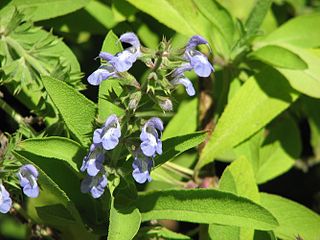
Salvia somalensis is a perennial shrub endemic to a limited range and elevation in Somalia. It grows at elevations from 4,000 feet (1,200 m) to 7,000 feet (2,100 m), typically in forest clearings or edges as a common or dominant subshrub.
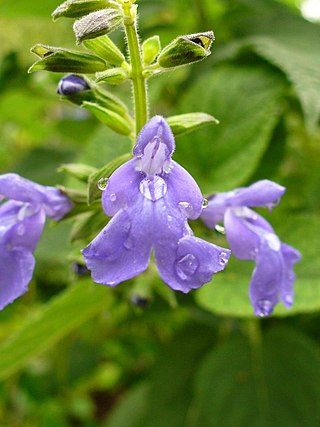
Salvia urica is a herbaceous perennial native to the mountains of Guatemala, Honduras, Belize, and Chiapas, Mexico. It is reportedly most common in Guatemala, where it grows in a wide variety of habitats from 1,000 to 8,000 feet elevation, in a mild and moist climate. The specific epithet, urica, means "caterpillar" or "cankerworm", possibly describing the tight whorls of flowers, calyces, and bracts before they open.

Salvia viscosa is a herbaceous perennial native to a small area of mountains in Lebanon and Israel. It was first described in 1781 by Nikolaus Joseph von Jacquin but only began being sold in nurseries in the 1990s.



















